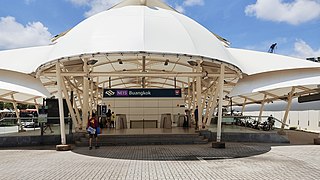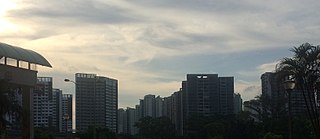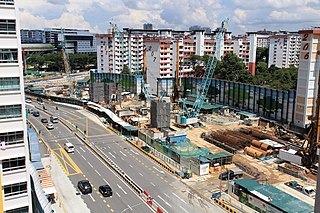
The Mass Rapid Transit system, locally known by the initialism MRT, is a rapid transit system in Singapore and the island country's principal mode of railway transportation. The system commenced operations in November 1987 after two decades of planning with an initial 6 km (3.7 mi) stretch consisting of five stations. The network has since grown to span the length and breadth of the country's main island – with the exception of the forested core and the rural northwestern region – in accordance with Singapore's aim of developing a comprehensive rail network as the backbone of the country's public transportation system, averaging a daily ridership of 3.4 million in 2019.

The North East Line (NEL) is a high-capacity Mass Rapid Transit (MRT) line in Singapore. Operated by SBS Transit, the 20-kilometre (12 mi) line is the MRT's shortest. It runs from HarbourFront station in southern Singapore to Punggol station in the northeast, serving 16 stations via Chinatown, Little India, Serangoon and Hougang. Coloured purple on official maps, it is Singapore's third MRT line and the world's first fully-automated underground driverless heavy rail line.

SBS Transit Ltd is a multi-modal public transport operator in Singapore operating bus and rail services. With a majority of its shares owned by Singaporean multinational transport conglomerate ComfortDelGro Corporation at 75%, it was formerly known as Singapore Bus Services before rebranding to SBS Transit on 1 November 2001.

The Punggol LRT is an automated guideway transit line in Singapore. The line, which initially opened on 29 January 2005, connects the residential districts and suburbs of Punggol to Punggol Town Centre, where it connects with the North East MRT line and the Punggol Bus Interchange. It is the third line of the LRT system in Singapore and like all other LRT lines, it is fully elevated and uses automated trains.

The Sengkang LRT is a 10.7-kilometre (6.6 mi) automated guideway transit line in Singapore. The line, which initially opened on 18 January 2003, connects the residential districts and suburbs of Sengkang to Sengkang Town Centre, where it connects with the North East MRT line, Sengkang Bus Interchange, Compass One and Compassvale Bus Interchange. It is the second line of the LRT system in Singapore and like all other LRT lines, it is fully elevated and uses automated trains. It is the first LRT line to be operated by SBS Transit.

The Light Rail Transit (LRT) is a series of localised automated guideway transit systems acting as feeder services to the heavy rail Mass Rapid Transit, which together forms the core of Singapore's rail transport services. The first LRT line was opened in 1999 and the system has since expanded to three lines, each serving a new town, namely Bukit Panjang LRT line, Sengkang LRT line and Punggol LRT line. Trains on these lines have at least one station interchange link to the MRT.

Buangkok MRT station is an underground Mass Rapid Transit (MRT) station on the North East line (NEL) in Sengkang, Singapore. Located underneath Sengkang Central near the junction with Compassvale Bow, Buangkok station is one of the two MRT stations located within the Sengkang planning area and serves the town of Buangkok. The station is operated by SBS Transit.

Rail transport in Singapore mainly consists of a passenger urban rail transit system spanning the entire city-state: a rapid transit system collectively known as the Mass Rapid Transit (MRT) system operated by the two biggest public transport operators SMRT Trains and SBS Transit, as well as several Light Rail Transit (LRT) rubber-tyred automated guideway transit lines also operated by both companies. In addition, local specialised light rail lines are in operation in places such as the Singapore Changi Airport and Sentosa.

Kim Chuan Depot is a train depot for the Mass Rapid Transit system in Singapore. The depot is constructed fully underground and provides maintenance, stabling and operational facilities for the Circle line. It is located in Hougang, along Upper Paya Lebar Road, and is accessible via Kim Chuan Road.

Fernvale is a neighbourhood of Sengkang New Town in Singapore. It is located between Sungei Punggol and the proposed Sengkang West Industrial Estate. The house numbers of the public apartment blocks in Fernvale begin with the number '4' (4xx). Fernvale is the newest neighbourhood in Sengkang Town to be completed by the Housing and Development Board (HDB). Seletar Mall, a new shopping amenity which houses Sengkang's first cineplex, is located within this neighbourhood. In 2017, A proposed community facility to be located next to Seletar Mall was announced, which houses a community club, childcare centre, hawker centre and wet market. The community facility which was slated to be ready by the second half of 2020, had stopped construction in April 2020 due to the COVID-19 measures set by the government. Construction of the facility has since continued in the second half of 2020 and was completed in 2022.

Sengkang is a planning area and residential town located in the North-East Region of Singapore. The town is the second most populous in the region, being home to 249,370 residents in 2020. Sengkang shares boundaries with Seletar and Punggol in the north, Pasir Ris and Paya Lebar in the east, Hougang and Serangoon to the south, as well as Yishun and Ang Mo Kio to the west.

Riviera LRT station is an elevated Light Rail Transit (LRT) station in Punggol, Singapore. Serving the east loop of the Punggol LRT line (PGLRT), the station is along Punggol East between the junctions of Punggol Central and Punggol Field. Surrounding landmarks include Punggol Joint Temple and Punggol Promenade Riverside Park.

The North-East Region of Singapore is one of the five regions in the country. The region is the most densely populated and has the highest population among the five, with Sengkang being its most populous town as of 2020 and Seletar as the regional centre. Comprising 13,810 hectares, it includes seven planning areas and is largely a residential region with 217,120 homes. Housing largely consists of high-density HDB public housing estates, however private housing is also present in the region. As its name implies, it is located in the north-eastern part of Singapore.

Punggol MRT/LRT station is a Mass Rapid Transit (MRT) and Light Rail Transit (LRT) interchange station in Punggol, Singapore. It is an interchange station between the North East line (NEL) and Punggol LRT (PGLRT), and the only MRT station located within Punggol planning area. Stretching across Punggol Central, the station is situated next to Punggol Temporary Bus Interchange and the retail development of Waterway Point.

Sengkang MRT/LRT station is a Mass Rapid Transit (MRT) and Light Rail Transit (LRT) interchange station in Sengkang, Singapore. It is an interchange between the North East line (NEL) and Sengkang LRT (SKLRT). Along with Buangkok station, it is one of the two MRT stations located within the Sengkang planning area.

Choa Chu Kang MRT/LRT station is an above-ground Mass Rapid Transit (MRT) and Light Rail Transit (LRT) interchange station in Choa Chu Kang, Singapore. It is an interchange between the North South line and Bukit Panjang LRT, serving as the western terminus of the latter. The station is located between Choa Chu Kang Bus Interchange and Lot One in the Choa Chu Kang town centre.

The Cross Island Line (CRL) is a high capacity mass rapid transit (MRT) line under development in Singapore. It will run in an east–west direction from Changi to Jurong Industrial Estate via Loyang, Pasir Ris, Hougang, Ang Mo Kio, Sin Ming, Bukit Timah, Clementi and West Coast. From Pasir Ris, the line will branch off to Punggol. The 58-kilometre (36 mi) line will replace the East West Line as the longest line on the MRT network upon its complete opening by the 2040s, serving about 27 stations.
In Singapore, the main lines on the Mass Rapid Transit system using the 1,435 mm standard gauge.

The Mitsubishi Heavy Industries Crystal Mover C810 is an automated people mover train that serves the Sengkang LRT line and Punggol LRT line in Singapore. The trains have been operating since 18 January 2003, with its first service on the Sengkang East Loop.
The Mitsubishi Heavy Industries Crystal Mover C810D is an automated people mover vehicle which serves the Sengkang LRT line and Punggol LRT line as the third generation train after their previous counterparts Mitsubishi Heavy Industries Crystal Mover C810 and Mitsubishi Heavy Industries Crystal Mover C810A.






















